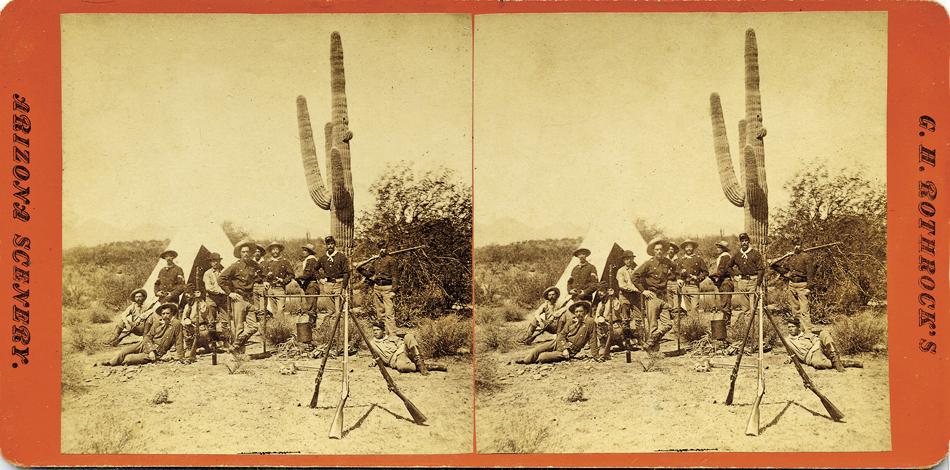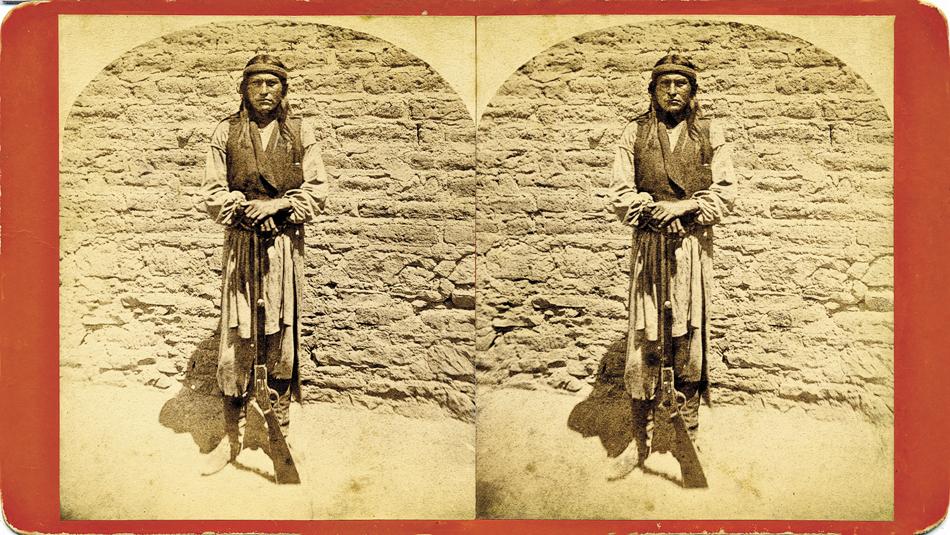 Arizona evolved slowly before the American Civil War. The 1860 census reported a population of only 6,482 people with 4,040 listed as American Indian. Most of the 2,421 “white” population lived in one of Arizona’s two major settlements, Tucson and the area later known as Yuma.
Arizona evolved slowly before the American Civil War. The 1860 census reported a population of only 6,482 people with 4,040 listed as American Indian. Most of the 2,421 “white” population lived in one of Arizona’s two major settlements, Tucson and the area later known as Yuma.
The natives on the Gila Indian Reservation, which had been created on the Gila River in central Arizona on February 28, 1859, represented most of the population of central Arizona.
In 1863, the same year Arizona became a U.S. territory, Rudolph D’Heureuse appears to be the first to leave evidence of his work. An itinerant French photographer, D’Heureuse worked for the Geological Survey of California that explored the Mohave Desert in 1863. The survey party traveled across Cajon Pass, from San Bernardino to El Dorado Canyon on the Colorado River, and on to Fort Mohave. With his wet plate camera, D’Heureuse made the earliest extant photographic images of Arizona, producing views of the Paiutes and Fort Mohave. A portion of D’Heureuse’s work is now housed at the Bancroft Library at UC Berkeley.
In 1864, photographer H.H. Edgerton entered Arizona Territory. Little is known about Edgerton other than that he produced 23 photographs of Arizona, Baja California and northwestern Mexico. He presented these, circa 1866, to Capt. Edgar Wakeman, who piloted the steamship John L. Stephens in the early 1860s.
By the 1870s, John Wesley Powell and George Wheeler’s survey stereographs of the Grand Canyon had vaulted Arizona into the popular culture. In the late fall and early winter of 1873, Dudley P. Flanders traveled on one of the first commercial ventures to document the territory. Arriving by stage from San Bernardino, California, he photographed stagecoach stops en route to Camp Beale Springs, Prescott and Wickenburg. The approximately 110 stereographs Flanders published as “Scenes in Arizona” provide incredible insight to the life and times of Territorial Arizona.
George Rothrock found himself on the newly established San Carlos Reservation during the height of the conflict with Geronimo and Chiricahua Apaches. His portraits include stereographs of Pinal Apache Chief Eskiminzin, a survivor of the 1871 Camp Grant Massacre, and of young Chiricahua leader Naiche. On a trip to Casa Grande, he left graffiti advertising his services and photography gallery in Phoenix. His marks remain to this day on the wall of the lower cave just above the water level.
Enoch Conklin reached Yuma on September 29, 1877. During his tour of southern Arizona, organized by Col. J.D. Graham, secretary of the Aztec Mining Company, Conklin traveled to Ehrenberg, Casa Grande, Tucson and ultimately Tubac, to visit the Aztec mines in the Santa Rita Mountains. Continent Stereoscopic Company got his picturesque chronicle published in 1878.
Fewer than 1,000 photographers and publishers produced 95 percent of the tens of millions of stereographs made in America, pioneer stereo researcher William Culp Darrah estimated. About 20 photographers and a dozen publishers were responsible for producing virtually all the stereographs made in Arizona, up to the 1930s, when the steady stream of new images in illustrated weekly magazines reduced the popularity of card-mounted stereographs nationwide. We are fortunate to have such an incredible early photographic record of Arizona.
This edited excerpt is courtesy Arizona Stereographs, 1865-1930 by Jeremy Rowe and published by Carl Mautz Publishing. Limited editions are available for purchase at CarlMautz.com or by calling 530-478-1610. Visit VintagePhoto.com for more on Rowe and his collection.
Photo Gallery
– All images courtesy Collection of Jeremy Rowe Vintage Photography Vintagephoto.com –
Aiattaua, translated as a Beautiful Man, was chief of the Moapariats, a tribe of Indians in the valley of Moapa River, a tributary of the Rio Virgin, in southern Nevada, before construction of the Hoover Dam. John K. Hillers took this circa 1871 stereograph while he was working as a boatman for John Wesley Powell’s expedition.












